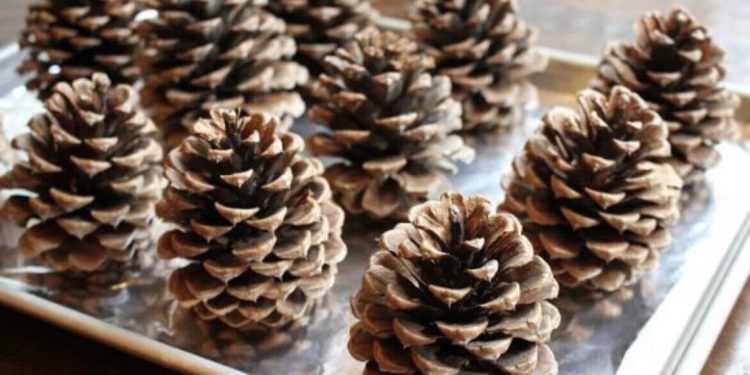Best areas for pine cone barriers:
Around newly planted bulbs (tulips, crocus) to deter squirrels.
Around vegetable beds to reduce pest access.
Around young trees or saplings for extra protection.
5. Eco-Friendly Plant Pot Filler
Large pots often require a lot of soil to fill, which can make them unnecessarily heavy and expensive.
Pine cones are an eco-friendly filler that:
Reduces the amount of soil needed.
Lightens the weight of large containers.
Still allows excellent drainage.
How to do it: Fill the bottom third of a large pot with pine cones, then add your potting soil above. The plants will thrive, and you’ll save money and effort!
6. Wildlife Habitat and Beneficial Insect Shelter
Pine cones provide natural shelter for beneficial insects like ladybugs, spiders, and pollinators. Keeping them in garden beds, under shrubs, or in insect hotels helps boost biodiversity and promote natural pest control.
Birds may also use pine cones as nesting material, or forage the seeds if any remain inside older cones.
Tip: Stack pine cones in loose piles in garden corners or under hedges to create small, hidden wildlife habitats.
7. Creative Garden Decor and Craft Projects
Beyond their practical uses, pine cones are beautiful, rustic elements that can enhance your garden’s aesthetics.
Use them to:
Line garden paths or edges for a whimsical, natural look.
Add to wreaths, fairy gardens, or seasonal garden displays.
Build DIY bird feeders (coat pine cones with peanut butter and seeds).
Their texture and shapes complement natural garden designs, blending seamlessly with wood, stone, and greenery.
8. Free and Abundant Resource
Perhaps one of the biggest reasons to collect pine cones is that they’re:
Completely free.
Sustainably gathered (without harming trees).
Abundantly available in many regions.
Instead of spending money on commercial soil amendments, mulches, or garden decor, you can turn fallen pine cones into functional assets for your home garden.
Best places to find them:
Forests and woodlands
Public parks (where permitted)
Your own backyard or neighborhood
How to Collect and Prepare Pine Cones for Garden Use
Collecting pine cones is easy, but preparing them properly ensures they’re safe and ready to use.
Step-by-Step Collection Guide:
1.Choose Mature Cones: Look for brown, woody cones that have fully opened. Green or tightly closed cones are not mature yet.
2. Avoid Moldy or Rotten Cones: Skip cones that are soft, moldy, or excessively weathered—they may carry pests or fungi.
3. Gather Responsibly: Only collect a portion of fallen cones, especially in wild areas, to leave resources for local wildlife.
How to Prepare Pine Cones for Gardening:
1.Clean Off Dirt and Debris: Shake off loose soil or insects. Use a dry brush if necessary.
2. Bake for Pest Control (Optional):
Preheat oven to 200°F (93°C).
Place pine cones on a foil-lined baking sheet.
Bake for 30–45 minutes to kill any hidden pests or fungi.
Watch carefully to avoid burning.
3. Allow to Cool and Store: Store dry, clean cones in mesh bags, baskets, or open bins until ready for use.
Important Tip: If using in compost or as a planter filler, breaking cones into smaller pieces speeds up decomposition and improves coverage.
Common Questions About Using Pine Cones in the Garden
Will pine cones make the soil too acidic?
Pine cones are slightly acidic, but when used as mulch or filler, they don’t significantly alter soil pH—especially when layered properly. For extremely pH-sensitive plants, compost pine cones first.
How long do pine cones take to break down?
Whole pine cones can take several years to fully decompose. Broken or shredded cones break down faster and enrich the soil with organic matter.
Are pine cones safe around all plants?
Yes! Pine cones are safe around most trees, shrubs, flowers, and vegetables. They’re especially useful for plants that prefer slightly acidic soils, such as blueberries, azaleas, and hydrangeas.
Pine cones aren’t just forest debris—they’re nature’s hidden gardening gem.
From improving soil health and conserving moisture to creating wildlife shelters and beautiful garden decor, these versatile treasures offer endless possibilities.
By collecting and using pine cones thoughtfully, you’re tapping into a sustainable, free resource that benefits your garden, your wallet, and the environment.
